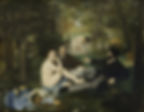Impressionism: A turning point in history of Art
- rohanguarda789
- May 22, 2020
- 2 min read
Updated: May 29, 2020

"For an impressionist to paint from nature is not to paint the subject, but to realise sensations" - Paul Cezanne
With the invention of the camera, the painters wanted something new, pleasant, vibrant and sensational to give to the world. They were tired of the world that everyone saw with the details and well blended colors and laying glazes upon glazes. They wanted to see the world in a new way, outside the studio in the light. It takes about seven minutes for the light to shift from an object and this changing light became the foundation for a new breed of painters, The Impressionists.

The atmospheric effects in the paintings painted by Turner and other painters largely influenced the Impressionists.
Impressionism is a 19th century art movement characterized by relatively small, thin, yet visible brush strokes, open composition, emphasis on the accurate depiction of light in its changing quality. Impressionism originated with a group of Paris based artists whose independent exhibitions brought them to prominence during the 1870s.
In the middle of the 19th century, the Academie des Beaux Arts dominated French art. They valued and preserved the traditional French painting standards of content and style. Historical subjects, religious themes, and portraits were valued: landscapes and still life were not.

In the early 1860s four young painters- Claude Monet, Pierre Auguste Renoir, Alfred Sisley, and Frederick Bazille discovered that they shared an interest in painting landscapes and contemporary life rather than historical and mythological scenes. They often ventured into the countryside to paint in the open air where they began to develop a lighter and brighter manner of painting. A favorite meeting place was the Cafe Guerbois on Avenue de Clichy in Paris where the discussions were often led by Edouard Manet whom the younger artists greatly admired. During the 1860s, the salon rejected a lot of work submitted by Monet and his friends. They also rejected Manet's 'The Luncheon on the grass' because it depicted a nude woman in contemporary setting whereas it accepted nudes in the mythological and allegorical settings. This deeply perturbed Manet's admirers.

Emperor Napoleon saw the rejected works and arranged the 'Salon of the refused' allowing the people to judge. While many viewers came only to laugh, the visitors to the Salon increased day by day than the regular Salon. Artists petitions requesting a new Salon was denied and therefore in 1873, Monet, Renoir, Pissarro, Sisley, Cezanne, Berthe Morisot, Edgar Degas and several others founded 'Cooperative and Anonymous association of painters, sculptors and engravers' to exhibit their artworks independently. In their inaugural exhibition, the critical response was mixed. Leroy an art critic declared that Monet's painting, 'Impression' was at most a sketch and could hardly be termed a finished work. But the term quickly gained favor with the public.
The techniques of impressionism include:
Short thick strokes of paint rather than detail
Colors are applied side by side with very less blending as possible
Greys and dark tones are produced by mixing complementary colors
Wet paint is placed into wet
Avoidance of glazes
Paint is applied to a white or light colored ground
The play of natural light is emphasized
Shadows are boldly painted with blue











